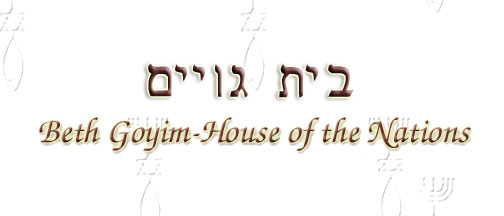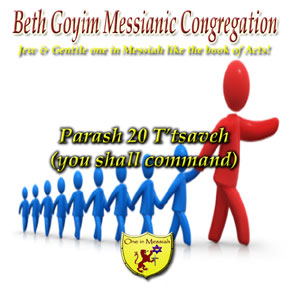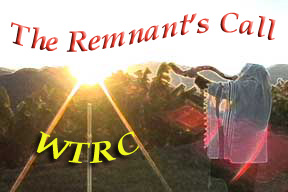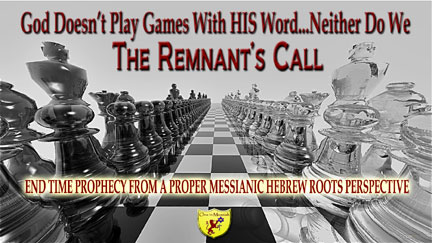 |
 |
 |
|
800 West 3rd Ave. Lexington, NC 27292 (973) 338-7800 |
||
|
|
||
P123 Parash 20 T’tsaveh (you shall command) Sh’mot/Exodus 27:20 – 30:10
Synopsis – God tells Moses to receive from the Children of Israel pure olive oil to feed the "everlasting flame" of the menorah, which Aaron is to kindle each day, "from evening till morning."
The priestly garments, to be worn by the Kohanim (priests) while serving in the Sanctuary are described. All Kohanim wore: 1) the ketonet -- a full length linen tunic; 2) michnasayim -- linen breeches; 3) mitznefet or migba'at -- a linen turban; 4) avnet -- a long sash wound above the waist.
In addition, the Kohen Gadol ("high priest") wore: 5) the efod, an apron-like garment made of blue, purple and red-dyed wool, linen and gold thread; 6) the choshen, a breastplate containing twelve precious stones inscribed with the names of the twelve tribes of Israel; 7) me'il -- a cloak of blue wool, with gold bells and decorative pomegranates on its hem; 8) the tzitz -- a golden plate worn on the forehead bearing the inscription "Holy to God".
Tetzaveh also includes God's detailed instructions for the seven-day initiation of Aaron and his four sons -- Nadav, Avihu, Elazar and Itamar -- into the priesthood, and for the making of the Golden Altar on which the ketoret ("incense") was burned.
Theme & Message – The focus of this portion of the Torah is the God who is holy. The God of the Israelites is first and foremost holy. In order to worship Him and in order to draw near to Him we must be willing to follow His instructions without deviation, variation and without question. The excellence of our Lord demands that we serve with excellence. The work of serving the King of Kings requires skill and wisdom. Not just any servant can serve inside the master’s house. Some servants work in the stables, some work in the fields, yet there are those who are skilled and trusted enough to work inside the house. There is no shame to be a servant of any kind in the master’s kingdom. However, the high honor of serving closest to the King is reserved for those who are willing to do the work preparing and sharpening their gifts and skills for the very hour they are called to serve inside the chambers of our King. The benefit of this obedience and high level of skill is to be able to be with our Lord and dwell with him intimately. We can then be his priests, his representatives on this earth. We will be given knowledge, power and wisdom to minister to the people on His behalf.
TORAH LESSON – This portion of the Torah begins with the instructions regarding the lighting of the lampstand. The priests were to use pure olive oil. The light in the tabernacle was to burn morning to evening and never is allowed to go out. This was to be a statute forever. The priests, Aaron and his descendents, were to be sanctified, or set apart in every aspect of their lives. Even their garments were unique. The Lord tells Moses to speak to a specific group of people who were chosen by God to be filled with wisdom and skill to make the garments. The word says the garments were made for glory and for beauty.
The garments of the high priest were made in the same colors as used in the tabernacle curtains and veils. These were gold, blue, scarlet and purple and linen. The first piece made was the ephod, a type of belted vest. The shoulder straps were connected together on the top using clasps of gold that had settings to hold two onyx stones each engraved with the names of the sons of Israel.
The breastplate was also woven of the same color fabric as the ephod, but attached to it were gold settings each holding gemstones representing the tribes of Israel. Each tribe was represented by a different color stone laid out on the breastplate in four rows of three stones each. The breastplate was secured on top by gold chains to the onyx clasps of the ephod. Blue cords tied the gold rings of the ephod and the breastplate together. The ephod contained an inside pocket, the pocket of judgment, in which was kept stones called the Urim and the Thummim. Both names are rendered in the plural in the original Hebrew text. Urim means the lights. Thummim means the perfections. Thus Aaron bore the judgment of the sons of Israel upon his heart and before God continuously
Beneath the ephod and the breastplate Aaron would wear a solid blue robe. The robe had a border around the neck to prevent it from being torn. Around the hem were sewn an alternating border of gold bells and pomegranates. This garment provided a sound for those outside the holy place to listen for Aaron’s movements within.
Aaron was to wear an engraved gold plate or crown tied to his forehead that read Holiness to Yehovah. This was so Aaron could bear the iniquities of the holy things which would be made holy by the gifts given by the Israelites. These gifts would be acceptable to God so long as this plate was worn by Aaron before the Lord.
Under these other garments was a robe of fine linen. All of the priests would wear similar robes tied with woven sashes of blue, scarlet and purple. The priests would wear a headband of the same woven cloth
After the proper garments were made, the priests had to be sanctified and the high priest had to be anointed. First, all the priests had to wash with water. Then the high priest had to don all of the special garments. His head was covered by the special turbin and the gold plate fixed to his head. The priests put on their linen robes and sashes. Their headbands were applied. The priests had to be sanctified by animal, bread, and wine sacrifices. All of the animals had to be without defects.
Then a bull was brought forward and all the priests placed their hands on its head. The bull was sacrificed at the door of the tent of meeting and some of its blood was placed on the altar and the rest poured out at the base of the altar. Its flesh was burned as a sin offering outside the camp. A ram was sacrificed after the priests laid their hands on its head. The blood was placed on the altar. A second ram was sacrificed after the priests laid their hands on its head. This time the blood was placed on the right ear, the right thumb and the right great toe of each priest. Each priest was sprinkled with blood and anointing oil.
Finally, the ram’s inner parts, fat, and the right thigh were waved before the Lord by Aaron. A loaf of bread, a cake with oil, and a wafer of matzah were waved. After the wave offering, the breads and the meats were burned as a sweet smelling aroma to the Lord. Aaron and his children were allowed to eat the meat and bread that were prepared for the sacrifice. No one from outside the priesthood could partake of this food.
A daily sin offering of a bull was to be given every day. The altar was to be made holy by seven days of atonement offerings, cleaning and anointing. A lamb was offered with a bread offering and wine every morning and every evening. This was to be done daily forever. Once the altar was sanctified, it became holy and anything that touched the altar was also made holy.
The last piece of inside furniture to be built was the incense altar. It was built of acacia wood and covered in gold. This altar was to be kept in the holy place outside the holy of holies. The incense was to be burned every morning and every evening when the lampstand was checked. Strict instructions were made that no other sacrifice other than the incense could be burned on this altar. Atonement could be made on the horns of this altar only once per year by the high priest.















